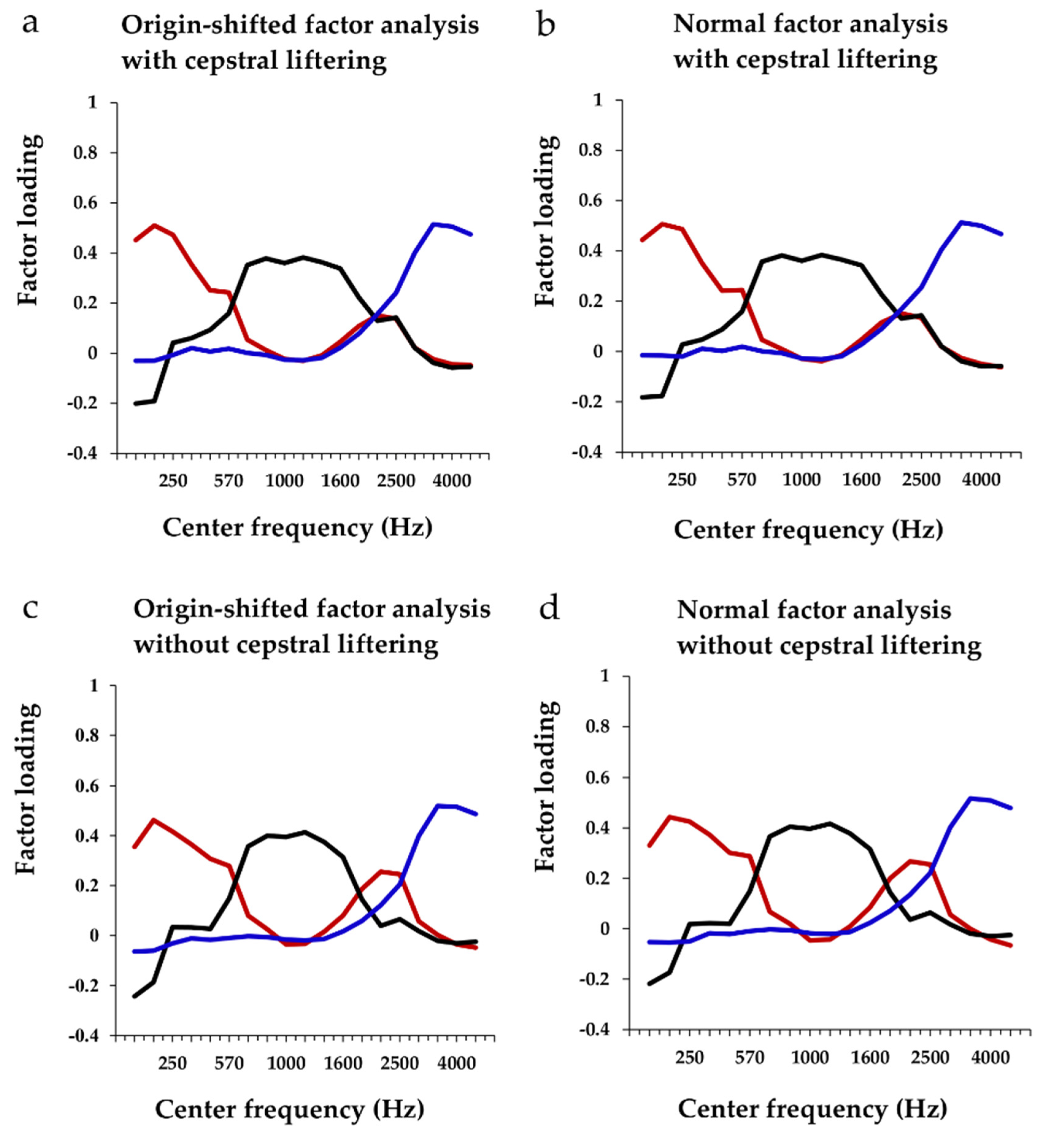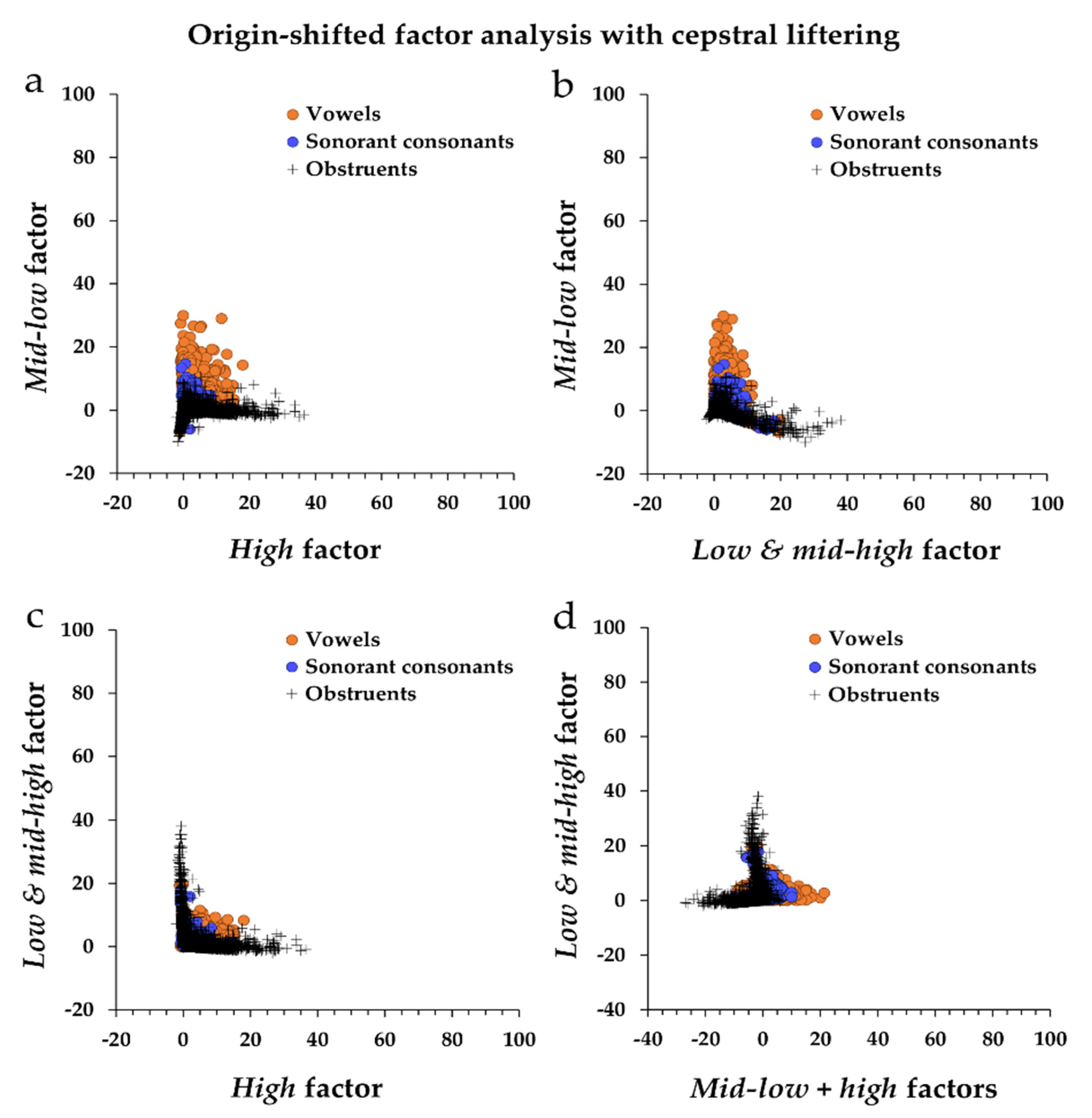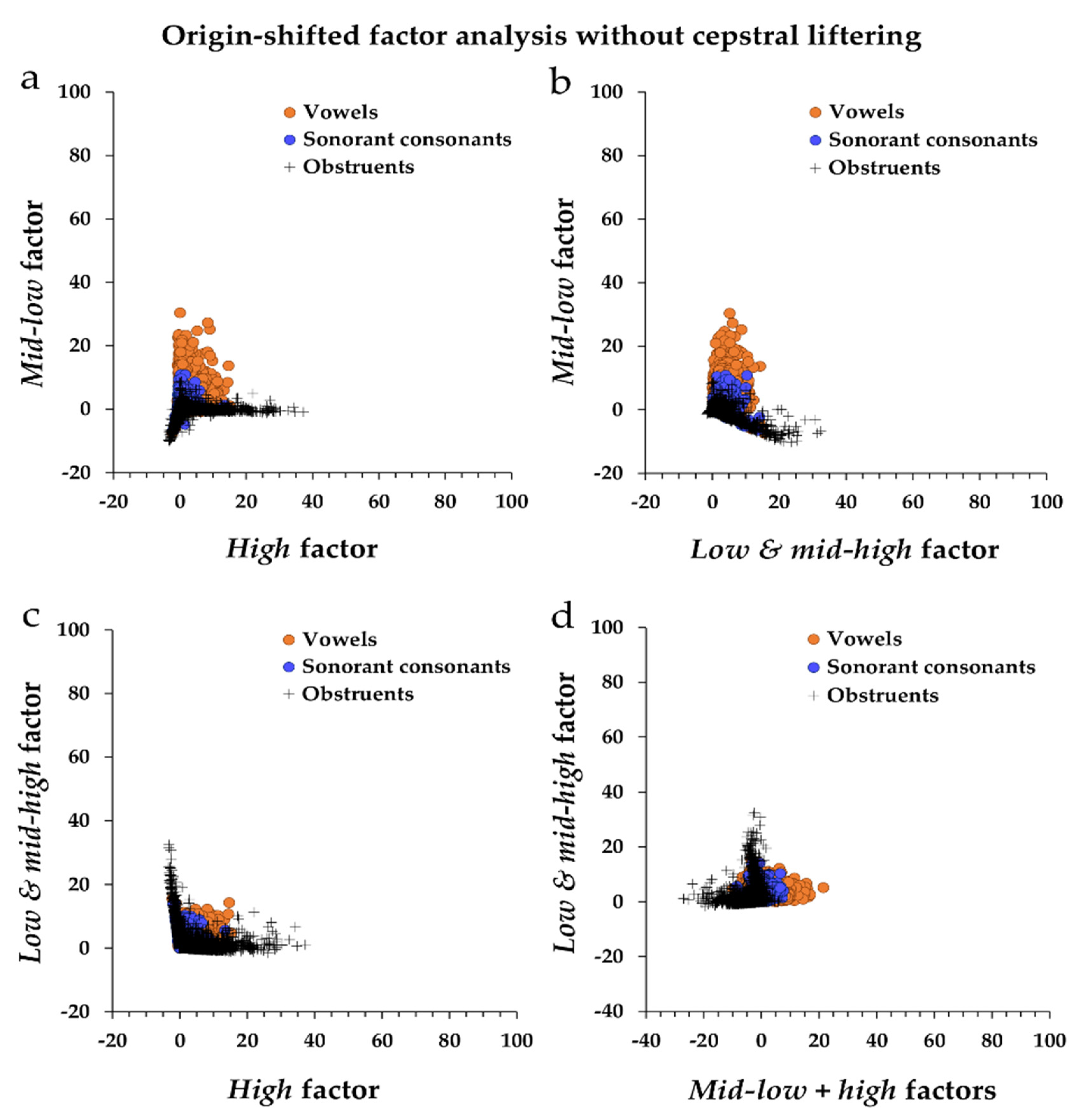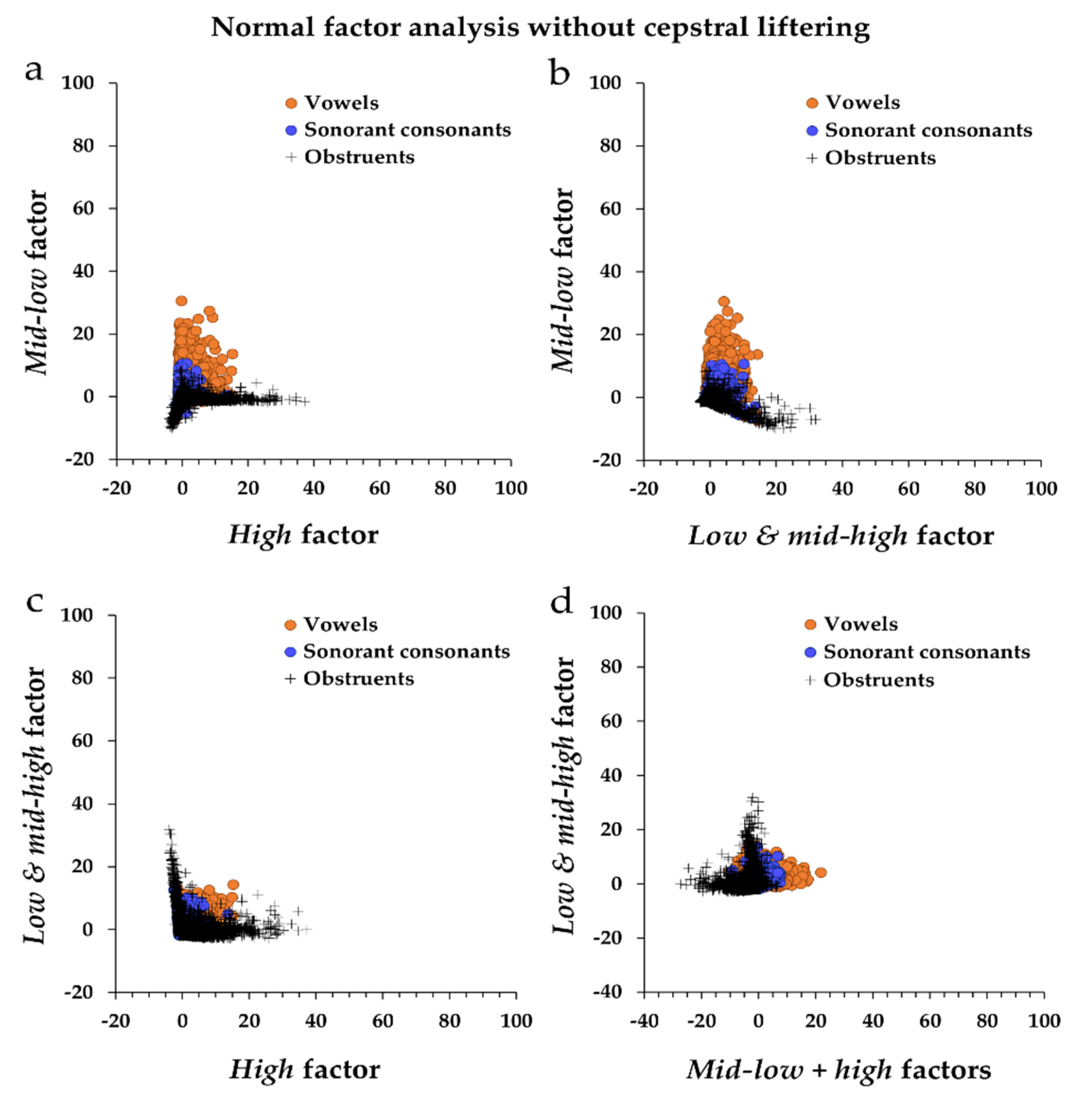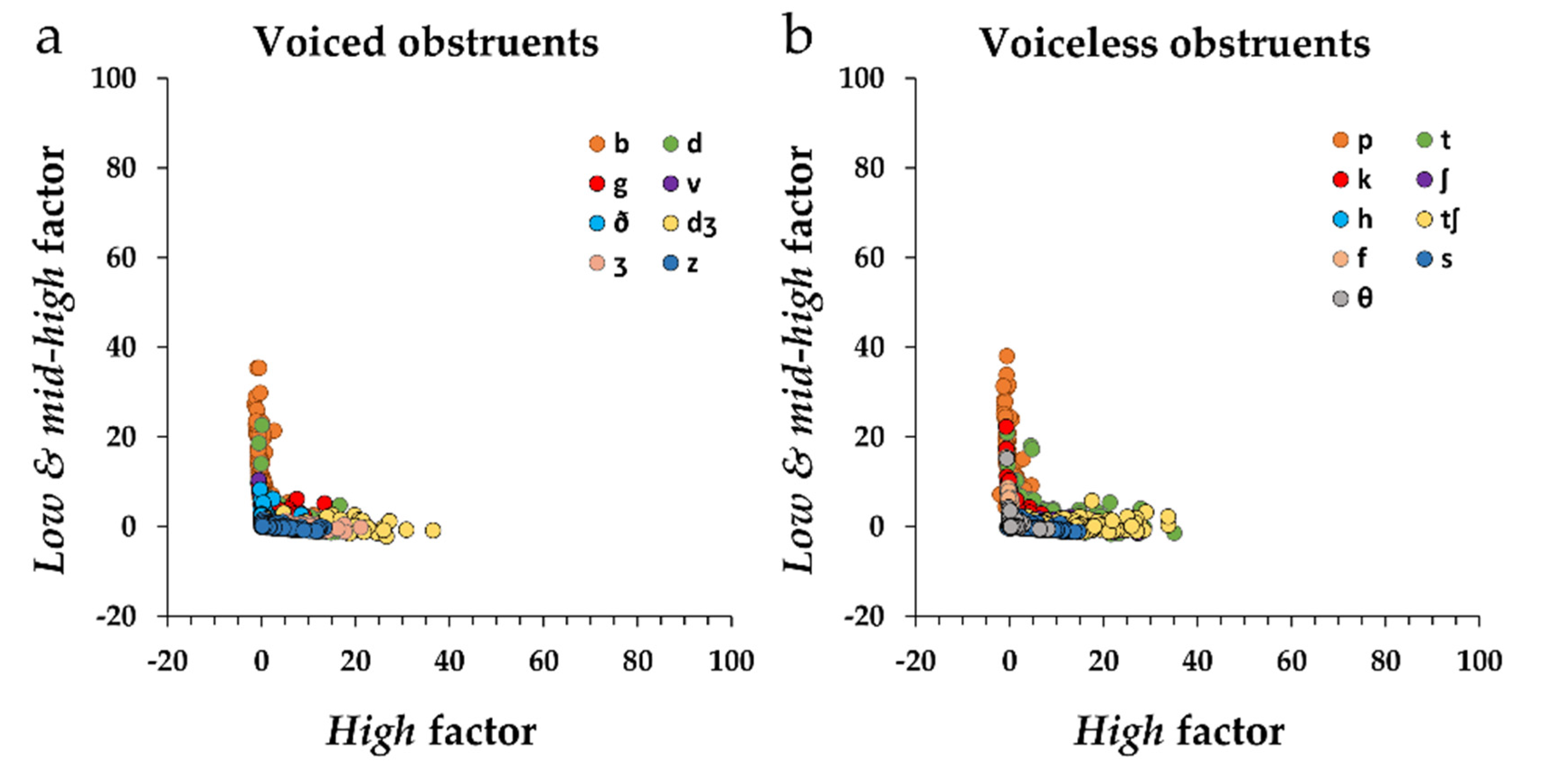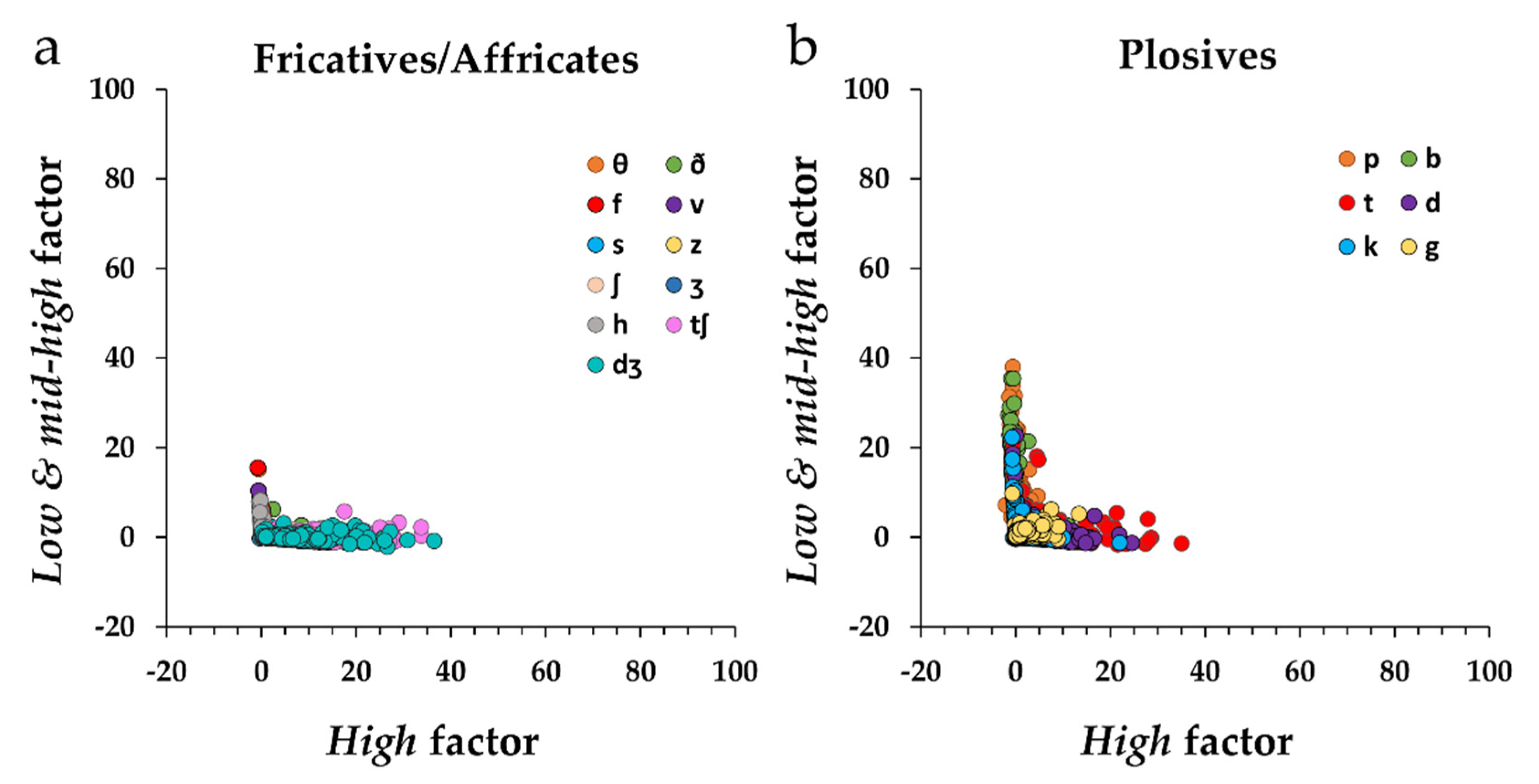3.1. Factor Loadings of the Three Spectral Factors
From the perspective of the analysis processes, the major differences between the two methods, i.e., the factor analyses in Nakajima et al. (2017) [
8] and in Kishida et al. (2016) [
12], were whether to use the cepstral liftering and the origin shift to the silent point.
Figure 1 shows the factor loadings for all the English speech samples spoken by the three native speakers, obtained with each of the four analysis methods. One division of the horizontal axis corresponds to 0.5 critical bandwidth. Four main frequency bands were obtained. The first constituted a low-frequency band, approximately from 50 to 600 Hz. The second was a mid-low frequency band, approximately from 600 to 1700 Hz, followed by a mid-high-frequency band, approximately from 1700 to 3000 Hz. Finally, the fourth range was a high-frequency band, approximately above 3000 Hz. Confirming the results of Ueda and Nakajima (2017) [
7], Nakajima et al. (2017) [
8], and Kishida et al. (2016) [
12], these four frequency bands were related to three spectral factors. One factor, the “low & mid-high factor” (
Figure 1, red line) was bimodal in that the frequencies of relatively high loadings were around 300 Hz and around 2300 Hz. The second factor, the “mid-low factor”, was located around 1100 Hz (
Figure 1, black line). The third factor, the “high factor”, was located around 4100 Hz (
Figure 1, blue line).
The cumulative contributions of the three spectral factors were around 43% in
Figure 1a,b, while they were around 45% in
Figure 1c,d. As can be seen by comparing
Figure 1a,b, or by comparing
Figure 1c,d, the origin shift did not greatly affect the factor loadings—the factor loadings with origin shift and without origin shift turned out to be very similar. Cepstral analysis, however, affected the factor loadings for just one factor. That is, the second peak of the bimodal “low & mid-high factor” was prominent without cepstral liftering, as can be seen in
Figure 1c,d, but was reduced with cepstral liftering, as shown in
Figure 1a,b. Thus, the similarity in the factor loadings between
Figure 1a,b or between
Figure 1c,d confirmed that the origin shift keeps the essential features of the factors in the analyses.
3.2. Factor Scores of the Three Spectral Factors
Following the analysis of the factor loadings, the factor scores were analyzed. In
Figure 2,
Figure 3,
Figure 4 and
Figure 5 below, panels (a), (b), and (c) show the distributions of combinations of the three spectral-factor scores, i.e., between the “low & mid-high factor” (around 300 and 2300 Hz), the “mid-low factor” (around 1100 Hz), and the “high factor” (above 3000 Hz). Panel (d) in
Figure 2,
Figure 3,
Figure 4 and
Figure 5 shows the distribution in the three-dimensional configuration as viewed in a direction from above-right to below-left in panel (a). In panel (d), the horizontal axis represents the combination of the “mid-low factor” and the “high factor”, by calculating (
x−
y)/
, where
x indicates the factor score of the “mid-low factor”, and
y the factor score of the “high factor”, following Nakajima et al. (2017) [
8].
The distribution of the factor scores showed a similar tendency in each of the four factor analyses (
Figure 2,
Figure 3,
Figure 4 and
Figure 5). Although the cepstral liftering had some influence on the factor loadings of the second peak of the bimodal “low & mid-high factor”, overall the factor scores showed very similar distributions in the factor space. The same can be said for the use of the origin shift. Whether the origin shift was applied or not, the factor loadings (
Figure 1a–d) and the factor scores (
Figure 2,
Figure 3,
Figure 4 and
Figure 5) showed very similar tendencies.
As can be seen, all phonemes were distributed into three fairly distinctive areas in the three-dimensional space. On the “mid-low factor”, the highest factor scores were obtained by vowels, then by sonorant consonants, while the lowest factor scores were obtained by obstruents. Most of the obstruents occupied a position very near to or below zero on the “mid-low factor”. By contrast, they occupied a position above zero on the “low & mid-high factor”, while on the “high factor” they even reached the highest factor scores. In the three-factor factor analysis, Nakajima et al. (2017) [
8] showed that the distribution of the three English-phoneme categories (i.e., vowels, sonorant consonants, and obstruents) constituted an L-shape in the two-dimensional factor space of the “high factor” and the “mid-low factor”. That is, the distributions of the phonemes linearly extended along both axes from the origin into the positive directions. Although not as clearly pronounced and narrowly shaped as in Nakajima et al. (2017) [
8], also in the present results, a rather similar L-shaped distribution was found as in
Figure 2,
Figure 3,
Figure 4 and
Figure 5a. Interestingly, the distribution of the obstruents also showed an L-shape in the two-dimensional factor space of
Figure 2,
Figure 3,
Figure 4 and
Figure 5c. The factor scores of obstruents were mutually exclusive between the “low & mid-high factor” and the “high factor”: If the factor score of the “low & mid-high factor” was higher, then the factor score of the “high factor” was very low, and vice versa. Generally, the L-shaped distribution of the factor scores of the obstruents across the “low & mid-high factor” and the “high factor” as analyzed here also appeared in Nakajima et al. (2017) [
8], but hardly in a noticeable way. In the present analyses, the L-shaped distribution appeared far more prominently.
Given the prominence of the L-shape for obstruents, more detailed analyses were performed.
Figure 6 shows that the distributions of voiced obstruents (
Figure 6a) and voiceless obstruents (
Figure 6b) indeed showed distinctive L-shapes as well. Here eight obstruents were categorized as voiced obstruents, with the number of analyzed data points in parentheses: /b/ (609), /d/ (838), /g/ (274), /v/ (467), /ð/ (968), /dʒ/ (53), /ʒ/ (54) and /z/ (827). Nine obstruents were categorized as voiceless obstruents: /p/ (563), /t/ (1682), /k/ (786), /ʃ/ (226), /h/ (340), /tʃ/ (195), /s/ (1389), /f/ (552), and /θ/ (205). For the voiced obstruents (
Figure 6a), three obstruents occupied a relatively high position on the “low & mid-high factor”, almost parallel to the y-axis, and close to the origin on the high factor: /b/, /v/, and /ð/, for which the factor scores of /v/ and /ð/ were around half of /b/. By contrast, four other voiced obstruents occupied a relatively high position on the “high factor”, almost parallel to the x-axis, and close to the origin on the “low & mid-high factor”: /g/, /ʒ/, /dʒ/and /z/, for which the factor scores of /g/ and /z/ were around half of /ʒ/ and /dʒ/. Only the factor scores of /d/ were both distributed on the “low & mid-high factor” and the “high factor”, yet again in an L-shape.
The distributions of voiceless obstruents (
Figure 6b), /p/, /k/, /h/, and /f/, displayed the L-shape, but they were mainly higher on the “low & mid-high factor”. The distributions of /t/ and /θ/ were also L-shaped, but they were mainly higher on the “high factor”. The distributions of three obstruents occupied a relatively high position only on the “high factor”, almost parallel to the x-axis, and close to the origin on the “low & mid-high factor”: /ʃ/, /tʃ/, and /s/, for which the factor scores of /s/ were about half of those of /ʃ/ and /tʃ/. In sum, the voiced obstruents /b/, /v/, and /ð/ were mainly related to the “low & mid-high factor”. The voiced obstruents /z/, /ʒ/ and /dʒ/ and the voiceless obstruents /ʃ/, /tʃ/, /s/ were mainly related to the “high factor”.
Figure 7 shows the distributions of all the obstruents divided into fricatives/affricates and plosives on the two-dimensional configuration, again clearly showing a distinctive L-shape. Here eleven obstruents were categorized as fricatives/affricates, with the number of analyzed data points in parentheses: /θ/ (205), /ð/ (968), /f/ (552), /v/ (467), /s/ (1389), /z/ (827), /ʃ/ (226), /ʒ/ (54), /h/ (340), /tʃ/ (195) and /dʒ/ (53). Six obstruents were categorized as plosives: /p/ (563), /t/ (1682), /k/ (786), /b/ (609), /d/ (838) and /g/ (274). For the fricatives/affricates (
Figure 7a), the distributions of six obstruents occupied a relatively high position on the “high factor”, almost parallel to the x-axis, and close to the origin on the “low & mid-high factor”: /s/, /z/, /ʃ/, /ʒ/, /tʃ/ and /dʒ/. The distributions of five obstruents were both located on the “low & mid-high factor” and the “high factor” in an L-shape: /θ/, /ð/, /f/, /v/, /h/, but they were mainly higher on the “low & mid-high factor”. As for the distributions of plosives (
Figure 7b), all of them displayed the L-shape, but /p/, /b/ and /k/ were mainly higher on the “low & mid-high factor”, and /t/, /d/ and /g/ were mainly higher on the “high factor”.
